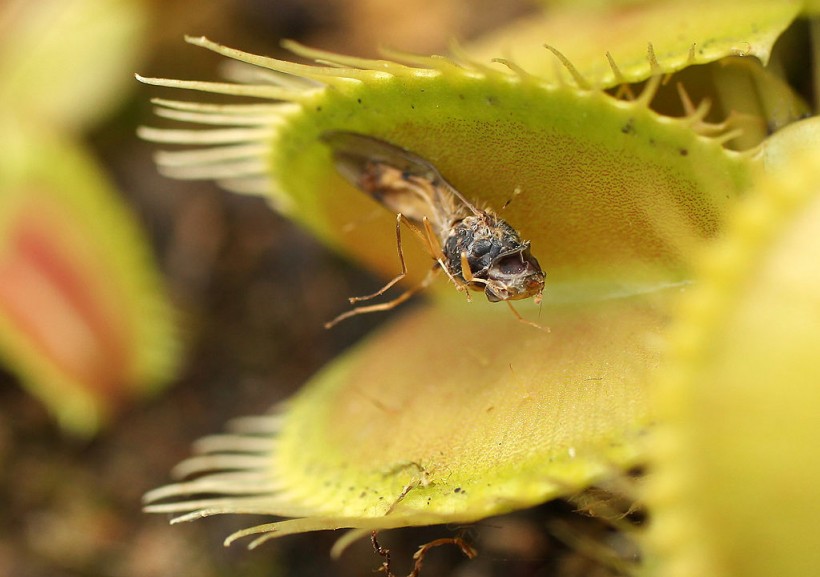Carnivorous plants are known for trapping and killing small animals, including insects and arthropods, as a means of an alternative consumption, while still using the biological process of photosynthesis as a method to gain energy.
While taxonomic database for these killer plants have increased in recent decades, botanists are continuing to search for unknown carnivorous plant species.
In a recent study, an international team of researchers from Ecuador, Germany, and the United States found two new carnivorous plant species, with an unusual appearance, in the Andes Mountains of Ecuador.
The two species belong to the butterworts genus, which consists of over a hundred flowering plant species that can catch and consume small insects using their sticky leaves as a bait.
New Carnivorous Plant Species

BERLIN, GERMANY - JULY 20: A Venus fly trap consumes a dead fly as it sits on display at a presentation of carnivorous plants at the Berlin-Dahlem Botanical Garden on July 20, 2013 in Berlin, Germany. Carnivorous plants derive most of their nutrients by consuming animals, most commonly flying, foraging, or crawling insects, and have adapted to grow in places where the soil does not contain enough nutrients for them to survive.
The findings in the study show that any final assessment of the Neotropical biodiversity is far from over; even in distinguished groups like carnivorous plants, wherein new taxa are continuously found and described.
Such discoveries occur in remote areas that have become accessible due to the continuance of urban expansion, according to the research article published in the journal PhytoKeys on March 24
The study's senior author, Tilo Henning, at the Leibniz Center for Agricultural Landscape Research, explained that "relentless urban sprawl" along with habitat loss and destruction is a major threat to biodiversity, as cited by the American Association for the Advancement of Science (AAAS).
In a news release on Monday, March 27, the research team presented the discovery of the two new carnivorous plants named Pinguicula jimburensis and Pinguicula ombrophila, which were found along a shore of a highland lagoon at an altitude of 3400 meters and situated on a nearly vertical rock face at 2900 meters.
The said plant species live within the "Amotape-Huancabamba" zone, which covers a large area of southern Ecuador and northern Peru.
Despite the evident rich biodiversity of the area, the study asserted that it will not be long before anthropogenic or human-induced climate change will impact the remote region.
Also Read: Scientist Have Uncovered Feeding Mechanisms of Slender Pitcher Plant Using Rain
Carnivorous Plants
As mentioned earlier, carnivorous plants are known for eating small animals for some reasons aside from the size between the plant predator and its prey.
According to the Botanical Society of America, carnivorous plants adapt to low-nutrient environments, where they obtain such sustenance by trapping and digesting different invertebrates and sometimes even small frogs and mammals.
Due to their track record of hunting insects, the said plants are sometimes called "insectivorous plants."
The US botanical organization highlights that most plants absorb nitrogen from the soil beneath them through their roots.
However, carnivorous plants acquire nitrogen from their animal prey through their trap-modified leaf.
In addition to butterworts (Pinguicula), also called as flypaper traps, below are some of the well-known carnivorous plants, as listed by the Natural History Museum:
- giant montane pitcher plant (Nepenthes rajah)
- cobra plant (Darlingtonia californica)
- low's pitcher plant (Nepenthes lowii)
- bat pitcher plant (Nepenthes hemsleyana)
- waterwheel plant (Aldrovanda vesiculosa)
- corkscrew plant (Genlisea violacea)
- parrot pitcher plant (Sarracenia psittacina)
- venus flytrap (Dionaea muscipula)
Related Article: Researchers Study the Molecular Basis of Carnivorous Plants and Found the Evolution of Them Through the Past
© 2024 NatureWorldNews.com All rights reserved. Do not reproduce without permission.

![Tsunami Hazard Zones: New US Map Shows Places at Risk of Flooding and Tsunamis Amid Rising Sea Levels [NOAA]](https://1471793142.rsc.cdn77.org/data/thumbs/full/70325/280/157/50/40/tsunami-hazard-zones-new-us-map-shows-places-at-risk-of-flooding-and-tsunamis-amid-rising-sea-levels-noaa.jpg)



